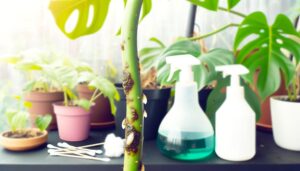How to Grow Monstera Deliciosa
Successfully cultivating Monstera deliciosa necessitates adherence to several horticultural best practices. Begin with a pot that offers extensive drainage to prevent root rot.
Employ a well-draining, nutrient-rich soil mix with ample organic matter. Provide bright, indirect light, adjusting seasonally to maintain consistent growth.
Utilize the 'soak and dry' watering method with room-temperature, dechlorinated water. Fertilize with a balanced, micronutrient-rich fertilizer periodically.
Support the plant's growth with moss poles or trellises, and prune and repot as necessary. Vigilantly manage common pests like spider mites and prevent fungal infections by controlling humidity and ensuring adequate air circulation.
Further insights await with an in-depth exploration.

Key Takeaways
- Choose a pot with multiple drainage holes and the right size for stability and root growth.
- Use well-draining, nutrient-rich soil with organic matter for optimal root health.
- Place in bright, indirect sunlight and adjust seasonally for consistent growth.
- Water using the 'soak and dry' method with room-temperature, dechlorinated water.
- Support growth with moss poles or trellises and secure stems to prevent damage.
Choosing the Right Pot
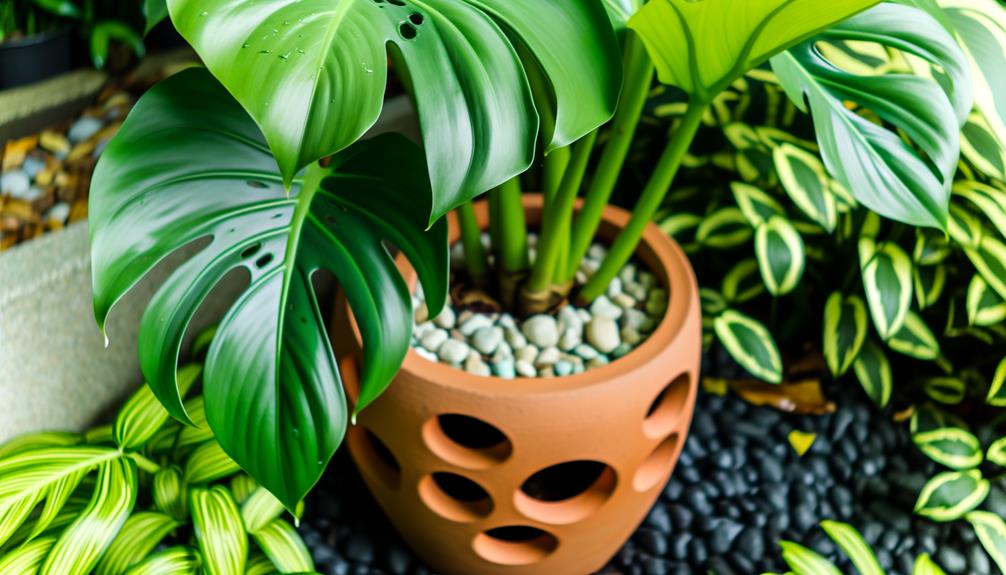
Choosing a suitable container for Monstera deliciosa is crucial for its prime growth and involves considering factors such as drainage, material, and size.
Sufficient drainage is essential to prevent waterlogging, which can result in root rot. Containers with multiple drainage holes are recommended.
The material of the container, whether terracotta, plastic, or ceramic, affects moisture retention and root aeration. Terracotta containers, for instance, are porous and encourage better aeration but may necessitate more frequent watering.
Size is another crucial factor; the container should be spacious enough to accommodate the Monstera's extensive root system while allowing room for growth. Choosing a container that is 2-4 inches larger in diameter than the plant's current root ball ensures ideal development and stability.
Selecting the Ideal Soil
Selecting the ideal soil for Monstera deliciosa necessitates understanding its preference for a well-draining, nutrient-rich medium that supports its aerial roots and robust growth. This tropical plant thrives in a balanced mix that mimics its natural habitat. Incorporating organic matter, such as peat moss or coco coir, enhances moisture retention while promoting aeration. Perlite or pumice should be added to guarantee drainage and prevent root rot.
| Component | Function | Proportion |
|---|---|---|
| Peat Moss/Coco Coir | Moisture Retention | 40% |
| Perlite/Pumice | Drainage | 30% |
| Pine Bark | Aeration | 30% |
This soil blend fosters ideal conditions, allowing the Monstera deliciosa to absorb nutrients efficiently and maintain healthy root systems.
Optimal Light Conditions
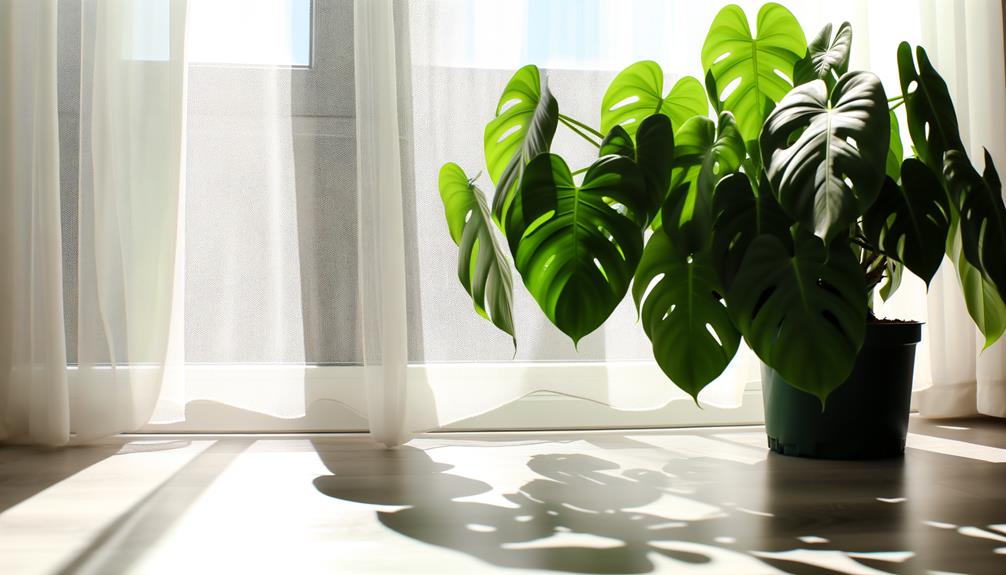
Monstera deliciosa thrives in environments with bright, indirect sunlight, which enhances photosynthetic efficiency without causing photodamage.
It is critical to avoid direct sun exposure, as it can lead to chlorophyll degradation and leaf scorch.
Seasonal adjustments in light placement may be necessary to maintain consistent light intensity, ensuring growth throughout the year.
Bright, Indirect Sunlight
To promote best growth and health, Monstera deliciosa thrives most effectively under bright, indirect sunlight, which simulates its natural tropical habitat conditions. The plant's large, fenestrated leaves are adapted to capture diffuse light that filters through the forest canopy.
For peak photosynthesis and growth, place the Monstera in a location where it can receive 2000 to 4000 lux of light intensity. Utilizing a light meter can provide precise measurements to maintain this range.
Additionally, natural light from east or west-facing windows is ideal, as it offers the necessary light spectrum without the risk of leaf burn. Adequate light exposure supports robust leaf development, ensuring the characteristic splits and holes that Monstera deliciosa is known for.
Avoid Direct Sun
Direct sunlight can cause photodamage to Monstera deliciosa, resulting in scorched leaves and impaired physiological functions. The chlorophyll within the foliage, essential for photosynthesis, degrades under excessive ultraviolet exposure, leading to chlorosis and necrosis.
Best light conditions for Monstera deliciosa involve bright, indirect light, which maximizes photosynthetic efficiency while minimizing cellular stress. Positioning the plant near an east-facing window or using sheer curtains to diffuse sunlight can create the ideal environment.
Light meters can be employed to measure lumens, ensuring levels between 10,000 to 20,000 lux. This range fosters robust growth and fenestration development. Avoiding direct sun will preserve the plant's turgor pressure and overall health, preventing photoinhibition and promoting vigorous foliage.
Adjusting for Seasons
Seasonal changes necessitate periodic adjustments to light exposure to guarantee Monstera deliciosa maintains peak photosynthetic activity and growth. During winter months, reduced daylight necessitates supplemental lighting, preferably full-spectrum grow lights, to compensate for diminished natural light.
Positioning the plant closer to windows or under artificial lighting guarantees it receives approximately 10-12 hours of light per day. Conversely, in summer, the intensity of sunlight increases; thus, indirect light or filtered sunlight is recommended to prevent photoinhibition and leaf scorch.
Monitoring the plant's light exposure with a quantum light meter can provide precise measurements, ensuring the plant's light requirements are met. Periodic rotation of the plant aids in uniform growth by exposing all sides to even light distribution.
Watering Your Monstera
Proper hydration is crucial for the health of Monstera deliciosa, requiring a balanced approach to avoid common issues such as root rot or dehydration. Monstera thrives in well-draining soil, necessitating a watering regimen that maintains a consistently moist but not waterlogged substrate.
Employing the 'soak and dry' method is advisable: thoroughly saturate the soil until water drains from the bottom, then allow the top two inches to dry before re-watering. Monitoring environmental factors such as humidity and temperature is critical, as higher humidity and warmer temperatures accelerate soil drying.
Utilizing a moisture meter can provide precise readings, ensuring ideal hydration. Always use room-temperature, dechlorinated water to prevent thermal shock and chemical-induced stress in the root system.
Fertilizing Tips
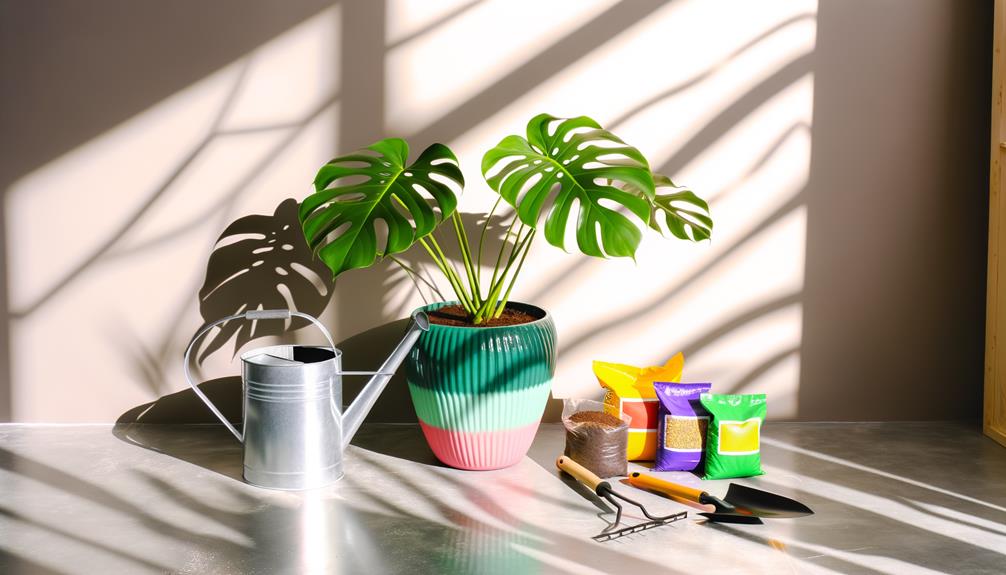
Administering a balanced fertilizer is crucial for promoting strong growth and sturdy foliage in Monstera deliciosa. A fertilizer with an N-P-K ratio of 20-20-20 is recommended, ensuring an even distribution of nitrogen, phosphorus, and potassium.
Application should occur every four to six weeks during the growing season (spring and summer). Dilute the fertilizer to half the recommended strength to prevent root burn and nutrient overload. Monitor the plant's response, adjusting frequency and concentration based on visible growth and health.
Additionally, incorporating micronutrients such as magnesium and iron can enhance leaf coloration and overall robustness. Avoid fertilizing during the plant's dormant phase in fall and winter to prevent unnecessary energy expenditure and potential root damage.
Pruning and Maintenance
To maximize growth and aesthetics, regular pruning and maintenance of Monstera deliciosa are essential, focusing on removing dead or damaged leaves and controlling the plant's size and shape. Employ sterilized pruning shears to excise necrotic or chlorotic foliage, mitigating potential pathogen spread.
Conduct pruning during the plant's active growth phase, typically spring to early summer, to minimize stress. Strategic removal of overgrown stems can enhance light penetration and air circulation, fostering robust, healthy growth.
Additionally, trimming aerial roots that overextend can maintain visual appeal without compromising structural integrity. Regular monitoring for pests and diseases, coupled with swift intervention, is necessary to sustain the plant's vitality.
Proper maintenance promotes an ideal environment for Monstera deliciosa, ensuring its longevity and aesthetic appeal.
Supporting Growth
Ensuring the best growth of Monstera deliciosa involves providing adequate structural support, such as moss poles or trellises, to accommodate its natural climbing habit and facilitate vertical development. This practice aids in the healthy proliferation of aerial roots and optimizes light exposure.
Implementing structural support can be systematically approached as follows:
- Install Moss Poles: Introduce a moss pole at planting to guide the plant's upward trajectory and provide moisture retention.
- Use Trellises: Utilize trellises for lateral support, ensuring leaves and stems are adequately spaced.
- Secure with Ties: Employ soft plant ties to gently anchor stems, preventing damage while encouraging adherence to the support.
- Regular Adjustment: Periodically adjust and secure stems to accommodate growth and prevent overcrowding.
Repotting Guidelines
Proper repotting practices are fundamental to maintaining the vigorous growth and health of Monstera deliciosa, especially as the plant outgrows its current container. Repotting should ideally be done biennially, using a pot that is 1-2 inches larger in diameter than the previous one. This guarantees sufficient space for root expansion and nutrient acquisition.
| Step | Description |
|---|---|
| Selection | Choose a pot with drainage holes to avoid waterlogging. |
| Soil Mix | Use a well-draining, peat-based potting mix. |
| Root Pruning | Trim excessively long roots to promote growth. |
| Transplanting | Gently move the plant, filling gaps with fresh soil. |
Following these guidelines will optimize the plant's physiological functions and enhance its overall aesthetic appeal.
Pest and Disease Control
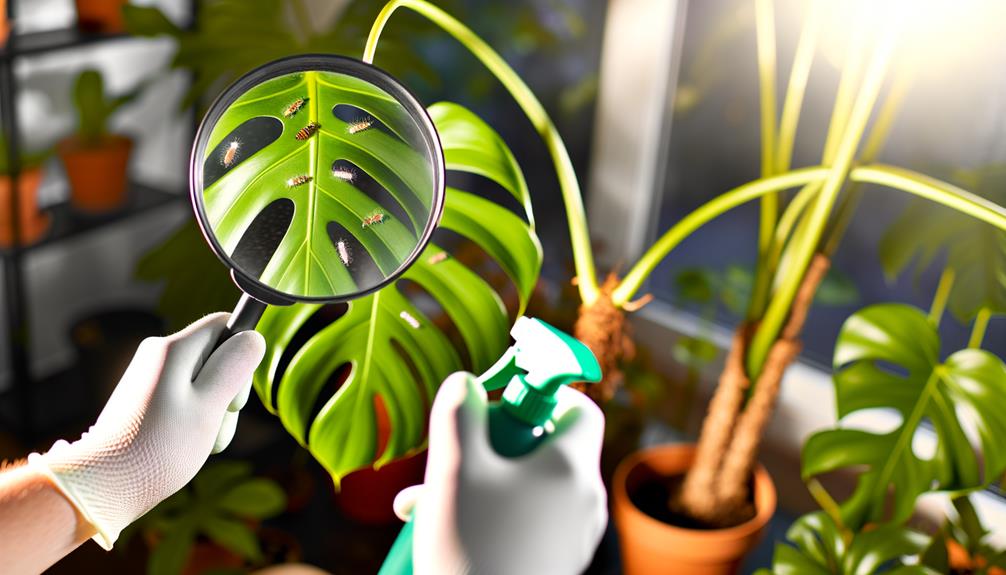
Effective pest and disease control is vital for maintaining the health of Monstera deliciosa. Common pests such as spider mites, mealybugs, and scale can cause significant damage if not managed promptly.
Additionally, preventing fungal infections through proper watering techniques and adequate air circulation is essential to mitigate the risk of foliar diseases.
Common Monstera Pests
Understanding the primary pests that affect Monstera deliciosa, such as spider mites, mealybugs, and scale insects, is crucial for implementing effective pest management strategies. Each pest presents unique challenges and requires targeted interventions.
- Spider Mites: These minuscule arachnids can cause stippling on leaves, leading to a silvery appearance. Regular inspection and maintaining humidity can help mitigate infestations.
- Mealybugs: Recognizable by their cotton-like masses, mealybugs excrete honeydew, promoting sooty mold growth. Systemic insecticides are often necessary for control.
- Scale Insects: These pests adhere to stems and leaves, forming protective shells. Horticultural oils can suffocate and eliminate them.
- Thrips: These slender insects feed on plant sap, causing silver streaks and deformities. Biological controls like predatory insects can be advantageous.
Implementing these strategies guarantees healthy Monstera growth.
Preventing Fungal Infections
Preventing fungal infections in Monstera deliciosa necessitates rigorous monitoring of environmental conditions, particularly humidity and air circulation, to inhibit the growth and spread of pathogenic fungi.
The humidity levels should range between 40-60%, as excessive moisture can foster fungal proliferation. Employing a hygrometer can aid in maintaining these parameters.
Adequate air circulation is essential; utilizing fans or strategically placing the plant in well-ventilated areas can alleviate stagnant air, reducing fungal spore viability.
Regular inspection of foliage for early signs of infection, such as leaf spots or discoloration, is important. Implementing fungicidal treatments, specifically formulated for ornamental plants, can serve as a prophylactic measure.
Pruning infected leaves and ensuring sterilization of tools further mitigates infection risks.
Propagating Monstera Deliciosa
Propagating Monstera deliciosa involves utilizing stem cuttings that include at least one node and an aerial root, ensuring ideal conditions for root development and subsequent plant growth.
To propagate effectively, follow these steps:
- Selection of Cutting: Choose a healthy stem with at least one node and an aerial root visible. This is essential for successful rooting and growth.
- Cutting Technique: Use sterilized pruning shears to make a clean cut below the node, minimizing plant tissue damage and infection risk.
- Rooting Medium: Place the cutting in water or a well-draining soil mix to promote root initiation. Maintain high humidity and indirect light conditions.
- Monitoring Growth: Regularly check for root development, which may take several weeks. Transplant the cutting to a larger pot once substantial roots form.
Conclusion
To sum up, guaranteeing the successful growth of Monstera deliciosa involves:
- Selecting the suitable pot
- Choosing nutrient-rich soil
- Providing ideal light conditions
- Maintaining consistent watering schedules
- Applying appropriate fertilizers
- Offering structural support
- Following repotting guidelines
- Implementing effective pest and disease control measures
By mastering these horticultural practices, one can promote vigorous growth, enhance plant health, and achieve a thriving Monstera deliciosa.
Employing propagation techniques further secures the perpetuation and expansion of this iconic tropical species.

